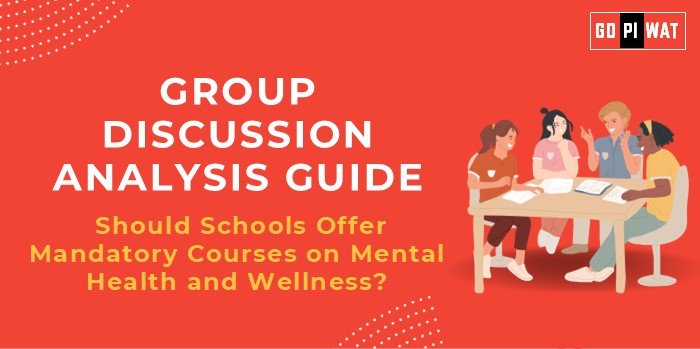📋 Group Discussion Analysis Guide: Should Schools Offer Mandatory Courses on Mental Health and Wellness?
🌐 Introduction to the Topic
Opening Context: “Mental health has emerged as a critical issue, with studies showing that over 15% of teenagers worldwide experience mental health challenges.”
Topic Background: The push for mental health education in schools is gaining momentum globally as institutions realize the role of early intervention in fostering well-rounded individuals. Mental health issues among students, exacerbated by academic pressure and social media, underscore the need for structured wellness education.
📊 Quick Facts and Key Statistics
– ⚠️ Suicide Rates: In 2023, suicide was the second leading cause of death among 15-29-year-olds worldwide.
– 📚 UNESCO Data (2023): 43% of schools in high-income countries have mandatory mental health programs, compared to only 12% in low-income countries.
– 🇮🇳 Indian Context: A survey revealed 45% of Indian students feel stressed due to academics; only 10% have access to school counselors.
🤝 Stakeholders and Their Roles
- 🏛️ Government Agencies: Develop and implement curriculum guidelines, allocate funding, and ensure policy execution.
- 🏫 Schools and Educators: Train staff to deliver mental health courses and create a supportive environment.
- 👨👩👧 Parents: Reinforce learnings at home and collaborate with schools to support student wellness.
- 🌍 NGOs and Experts: Provide expertise, tools, and training programs to enhance awareness and efficacy.
- 🧑🎓 Students: Actively participate in courses to develop coping mechanisms and awareness.
🏆 Achievements and Challenges
✨ Achievements
- ✅ Reduced Stigma: Schools implementing such programs, like in Finland and Canada, have seen reduced stigma.
- 📈 Improved Academic Outcomes: Enhanced performance and behavior in schools offering wellness classes.
- 🌐 Successful Pilots: Bengaluru’s program showed 70% of students reporting better stress management.
⚠️ Challenges
- 🔍 Lack of Trained Counselors: Particularly in rural schools.
- ❌ Cultural Resistance: Stigma and additional curriculum burdens deter stakeholders.
- 💵 Financial Constraints: Limited resources for program implementation.
🌍 Global Comparisons
- 🇫🇮 Finland: Embedded mental health education in the curriculum, reducing youth depression rates.
- 🇺🇸 USA: Despite programs, cultural stigma and funding gaps persist.
💬 Structured Arguments for Discussion
Supporting Stance: “Introducing mental health courses will equip students with life skills, reducing issues like anxiety, depression, and bullying.”
Opposing Stance: “Adding mandatory courses may overburden students and educators, detracting from core academics.”
Balanced Perspective: “While beneficial, mandatory courses require careful planning and phased implementation to avoid unintended consequences.”
📚 Effective Discussion Approaches
- 📊 Opening Approaches:
- 📈 Statistical Start: “Did you know that 1 in 7 adolescents globally face mental health challenges, and schools can be a first line of defense?”
- 💡 Problem-Solution Opening: “With academic stress on the rise, teaching mental health in schools could be the solution we need.”
- 🤝 Counter-Argument Handling:
- 💵 Cost-Effective Pilots: Highlight affordable pilot programs showing success.
- 📖 Life Skills Emphasis: Stress that life skills are as crucial as academics.
🔍 Strategic Analysis of Strengths and Weaknesses
– ⚠️ Weaknesses: Cultural resistance, lack of trained personnel, financial constraints.
– 🌟 Opportunities: Integration with online tools, public-private partnerships.
– ⚠️ Threats: Potential misuse of resources, lack of measurable outcomes.
📈 Connecting with B-School Applications
- 🌍 Real-World Applications:
- Projects in educational policy, CSR initiatives in mental health, and leadership development.
- ❓ Sample Interview Questions:
- 💬 “How would you balance mental health education and academic rigor?”
- 💡 “Can public-private partnerships help scale mental health programs in schools?”
- 📖 Insights for Students:
- Opportunities to design impactful programs.
- A growing field in policy and management.


